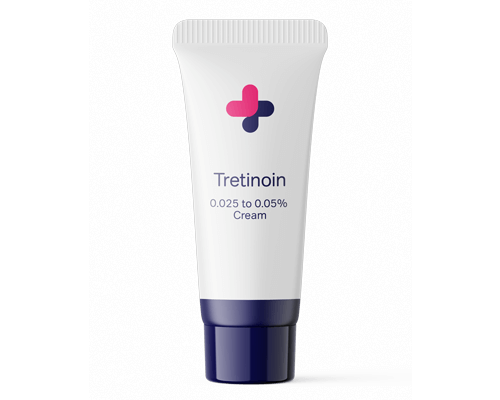Why choose Tretinoin?
Acne is the most common skin condition in the United States, affecting up to 50 million Americans annually. Approximately 85 percent of people between the ages of 12 and 24 experience at least minor acne.
Its ability to accelerate the skins cell turnover rate and significantly promote the production of collagen is why Tretinoin is widely considered by healthcare professionals as the prevailing solution in the correction, improvement and prevention of acne as well as its considerable anti-aging effects.
Cream vs. Gel
The main difference between the two agents is the texture. The gel form contains more alcohol and thus produces a more drying effect on the skin. For this reason, it is intended more for oily, acne-prone skin types. It is advised to use a hydrating moisturiser around 20 minutes after applying the gel to offset any dryness.
The cream-based solution is gentler and better suited for dry and aging skin. It is also recommended for use among patients during the winter months where weather conditions can be harsh for the skin.
Always consult with a doctor or certified dermatologist before deciding which treatment to use.
Tretinoin vs alternative treatments
Tretinoin is one of the most widely-used and effective treatment options for acne currently available on the market. In spite of this, the treatment is not necessarily the best choice for everyone and it does come with side effects; some can be fairly common while others are reported rare. For this reason, it may be useful to consider other treatment options in the event of an adverse reaction or undesired effect.
Tretinoin vs Retinol
While both treatments are a derivative of vitamin A which effectively stimulates skin renewal, Tretinoin is proven to be considerably more aggressive.
Retinol needs to be converted into retinoic acid by enzymes in the body before it can directly affect skin cells whereas Tretinoin does not need to go through such conversion as it is already acid.
Retinol is available to purchase over the counter at lower strengths and is deemed more soothing than its prescription counterpart, primarily owing to its moisturising and soothing ingredients.
Although Retinol contains fewer side-effects, ultimately Tretinoin appears to provide a better shot at combating acne and other skin-related issues.
Tretinoin vs Clindamycin
The components of Tretinoin essentially work by affecting the growth of skin cells while Clindamycin, in contrast, is an antibiotic that prevents the growth of acne-forming bacteria. Oftentimes, the two treatments are used in conjunction to efficiently treat severe acne.
Many of the side-effects are similar to that of Tretinoin including redness, itching, burning and worsening of acne in addition to the potential risk of diarrhea should the medication enter into the bloodstream.
Tretinoin vs Adapalene
Both Adapalene and Tretinoin have been proven to produce dramatic reductions, marked improvements and, in some cases, total clearance of acne.
Due to the severity of skin irritation produced by Tretinoin, many patients discontinue use before the treatment can take full effect. Adapalene offers comparable efficacy to Tretinoin while causing considerably milder side-effects and thus represents a good alternative in the treatment of acne.
In addition, there have been no reported problems in relation to Adapelene use and pregnancy-related complications while Tretinoin is considered unsafe for pregnant or nursing women. It is still important to consult with your doctor before using Adapalene whilst pregnant or breastfeeding.

















Quick and discreet
I ordered Azithromycin tablets for chlamydia treatment, received it next day in a brown discreet pack, and cheaper than all other pharmacies, can't ask for more
Jordan McCann